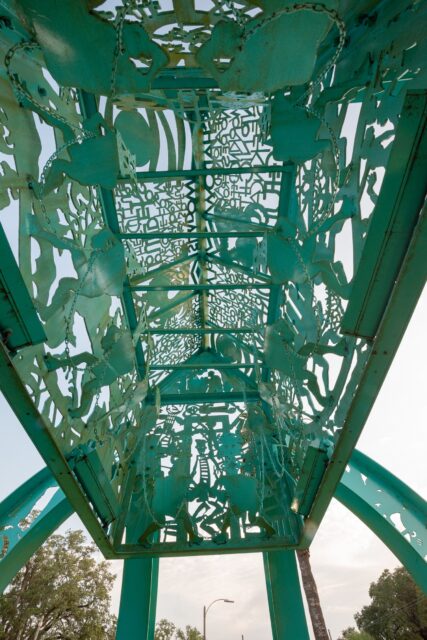John Scott: Dancing at the Crossroads
John Scott is the 2021 Humanist of the Year
Published: February 28, 2021
Last Updated: March 22, 2023

Xavier University of Louisiana, Archives and Special Collections
John Scott, right, at work in Xavier University’s Art Village.
Artist, teacher, mentor, and MacArthur “Genius” Fellow John T. Scott has been named the 2021 Humanist of the Year. Scott is the first posthumous recipient of the award. His life and work are the focus of two major Louisiana Endowment for the Humanities initiatives later this year: the opening of The Helis Foundation John Scott Center and publication of Passing It On: The Art of John T. Scott. Through the years, Scott and his work have graced the cover of two issues of 64 Parishes’ predecessor, Louisiana Cultural Vistas magazine. We are honored to continue LEH’s dedication to sharing his story and message.
John Scott’s 1996 work Dancing at the Crossroads is an impressive twenty-five feet in length, comprising a playful assemblage of geometric shapes constructed of steel. It integrates both the explosions of colors and techniques as well as the sharp edges that are Scott’s signature style. Dancing at the Crossroads is a monumental and exceptional work of art, and within its spaces, curves, and angles is a story from New Orleans about the persistence of the African sacred: the honoring of the ancestors, the syncopated rhythms of African American music and dance, and the struggle for civil liberties. Incorporating both mobile elements and levers as well as suspended components Dancing at the Crossroads sings and dances the history of the descendant communities of New Orleans.As an artist Scott used the term “jazz thinking” to describe his improvisatory manner as he spontaneously moved between mediums, creating works that explored the visual art of storytelling. He referred to his work at times as “kinetic blues” and spoke of his efforts to visually conjure the spatial vocabulary or essence of jazz in his oeuvre. Scott’s work conjures and beckons. It is magic and mysticism. And it illuminates the very core of who we are.

John Scott, Dancing at the Crossroads, 1996. Painted steel. Photo by Arthur Roger Gallery; Scott Family Collection.
Born in 1940 to a working class family, Scott was the fifth child of Thomas and Mary Mable Scott. Both parents were creatives, teaching Scott carpentry and embroidery, skills that would ignite his desire for a life devoted to the arts. A master of many media, Scott produced exceptional pen and ink drawings, prints, paintings, and calligraphy. But he is perhaps best remembered for his monumental metal sculptural works, ten of which grace the streets of New Orleans today. I cannot help but think of him, and his numerous works in iron and steel, as honoring and reviving the ancestral traditions of African blacksmiths and their important historical contributions to the visual landscape of the New Orleans metropolis.
In particular, Spirit House, created with his former student and close friend Martin Payton, best exemplifies Scott’s mode of execution and the important considerations of ancestors, history, and place that inform his oeuvre. Featuring a shotgun house, with spectral cut-outs of jazz musicians, African symbols, and silhouettes of laborers, Spirit House is dedicated to the enslaved Africans and their ancestors who contributed to the building of the city of New Orleans. But this ideal of veneration for the ancestors and their progeny was also reflected in the process of building the sculpture, which involved students from nearby Medard H. Nelson Elementary and St. Leo the Great School. The positioning of Spirit House was also intentional. Installed facing north at the intersection of Gentilly Boulevard, De Saix Boulevard, and St. Bernard Avenue, Spirit House casts a shadow to the west as the sun rises, referencing the forced and violent relocation of Africans to the Americas through the transatlantic slave trade. As the sun moves westward across the sky each day, the shadow of the sculpture migrates to the east, symbolically returning the spirit of those ancestors to their homeland.

John Scott and Martin Payton, detail of Spirit House, 2002. Painted marine-grade aluminum. Photo by Eric Waters.
You can find Scott all over New Orleans. Downtown more than five hundred sketchbooks of his ideas, thoughts, and memories survive, tucked into a small room of his family’s home. Uptown the Amistad Research Center’s archives hold notepaper with his dreams for new art forms, amongst other important ephemera, interviews, and photographs, and in the Central Business District the Louisiana Endowment for the Humanities’ headquarters at the corner of Lafayette and O’Keefe Streets holds the largest private collection of his works in the world.
LEH headquarters will be the new site for The Helis Foundation John Scott Center, opening fall 2021, and will continue Scott’s mission to educate and empower. Scott’s belief that “the ancestors expect for you to pass it on” has had a lasting impact both in his lifetime and on his legacy. After attending Xavier University as an undergraduate in the 1960s and then continuing his graduate work at Michigan State University, where he earned an MFA in sculpture and printmaking in 1965, Scott joined the faculty of Xavier University that same year. He was instrumental in building Xavier’s extensive collection of African and African American art and mentored many important African American artists who have continued his practice of passing it on. Throughout his career Scott taught nationally at universities and conferences throughout the United States as well as internationally in Europe and the Caribbean, always bringing the New Orleans story to other diasporic communities. But he also contributed to his local community, conducting workshops for kids, holding classes for artists and non-artists, and serving on the boards of arts and community organizations as well as advocating for arts education in public schools.
…the crossroads, with its implications of intersection and improvisation, is a recurring theme in Scott’s work.
Scott’s engagement with and commitment to the New Orleans community came out of the adversarial social conditions of his childhood. He grew up at a time of severe and legalized racial segregation, observing that “growing up in New Orleans in the forties and the fifties like I did was like walking through a land mine all the time.” Scott’s I Remember Birmingham series (1996–2005) specifically references the act of racially motivated terrorism on September 16, 1963, when a bomb, planted beneath the basement of the 16th Street Baptist Church in Birmingham, Alabama, exploded, killing four young girls and injuring dozens of others. Other acts of oppression inspired Scott to create art that called for social justice on a global scale. Through abstract and iconographic works that reference the Middle Passage, apartheid, enslavement, and contemporary systems of oppression, much of Scott’s work attempts to encompass the troubled history of colonialism and slavery that continues to affect people of African descent today.
In 1992 Scott received the prestigious “Genius Grant” from the John D. and Catherine T. MacArthur Foundation in honor of his exceptional contributions to the field of art. In true Scott fashion the award money was funneled back into Scott’s family and his community, his two major priorities.
John Scott was a humanist. He was also a devoutly spiritual man who attributed much of his work to the influence of God and the ancestors. He resided at the crossroads of cultural understanding; the crossroads, with its implications of intersection and improvisation, is a recurring theme in Scott’s work. In Africa and the Diaspora the crossroads is a symbol for both a metaphorical and literal line that separates the living and the ancestors. The circular periphery that encloses the crossroads provides space and direction for the circle dance. In an 2004 interview published in Sculpture, Scott explained:“There is a tradition in New Orleans that when you die you have to be sent off ‘right,’ some might call this a party. In New Orleans, we’re born with music. We live with music. And they bury you with music. Music is not just about entertainment. It’s a lot more. During the period of slavery there was a place called Congo Square where African people were allowed to go and ‘entertain’ themselves on Sundays. But what a lot of people don’t realize was that when Africans formed a circle, they had a sacred space and it became a religious ritual. That was the origin of the circle dance. And the circle dance evolved into the bam bola. And that evolved into the second line.”

Scott working with an unidentified nun during his tenure at Xavier. Xavier University of Louisiana, Archives and Special Collections.
In New Orleans circle dances and second lines became sites of transcendence where the spirit left the body and all its hardship.
Perhaps now we can look at Dancing at the Crossroads with more nuance—as a work that reflects the African metaphysical map of the human soul and the crossing of the paths of the living and the ancestors. Like much of his oeuvre, it suggests an alternative way to address human suffering and makes concrete important connections between past, present, and future that offer tremendous possibilities for healing from trauma through carefully controlled ritualized spaces.
With this work, and so many others, Scott created a space, both tangible and conceptual, where social identity and ancestral practices are encouraged and confirmed. Scott died of pulmonary fibrosis in 2007; his contribution to New Orleans and to the world can be found still living within his art forms, dynamic works that represent the endurance of tradition, kinship, and power through time and space. These works communicate more than the form and structure of an accomplished aesthete. They create a metaphysical space of conflict and resolution, death and resurrection, spirit and form, all communicated through the eternal dance for survival and continuity at the crossroads of New Orleans culture.
Dr. Sarah A. Clunis is originally from Kingston, Jamaica, and is the Director of the Xavier University Art Gallery, supervisor of the Art Collection team, and Assistant Professor of Art History at Xavier University of Louisiana. She is currently the Project Curator for The Helis Foundation John Scott Center at the Louisiana Endowment of the Humanities.
